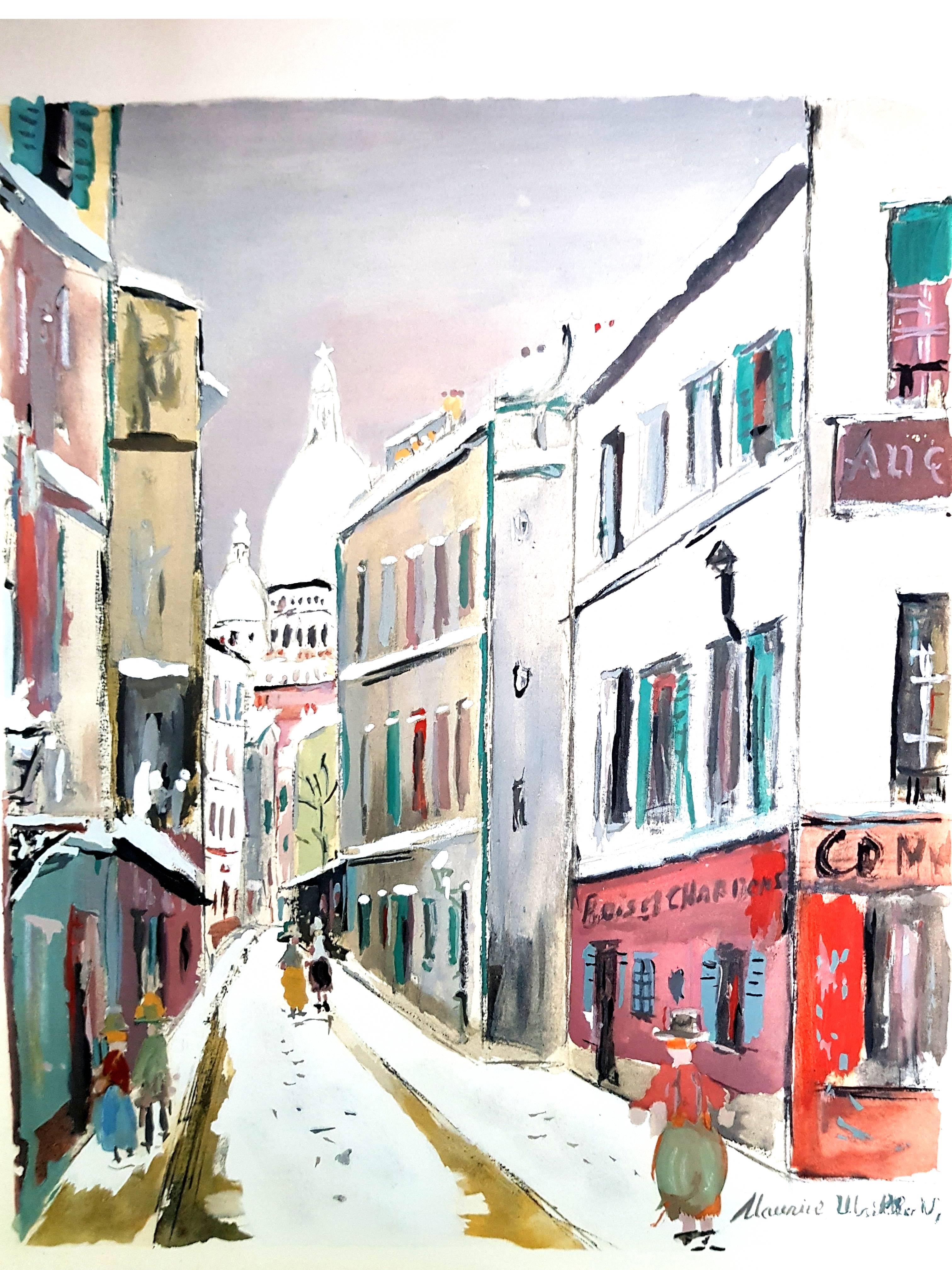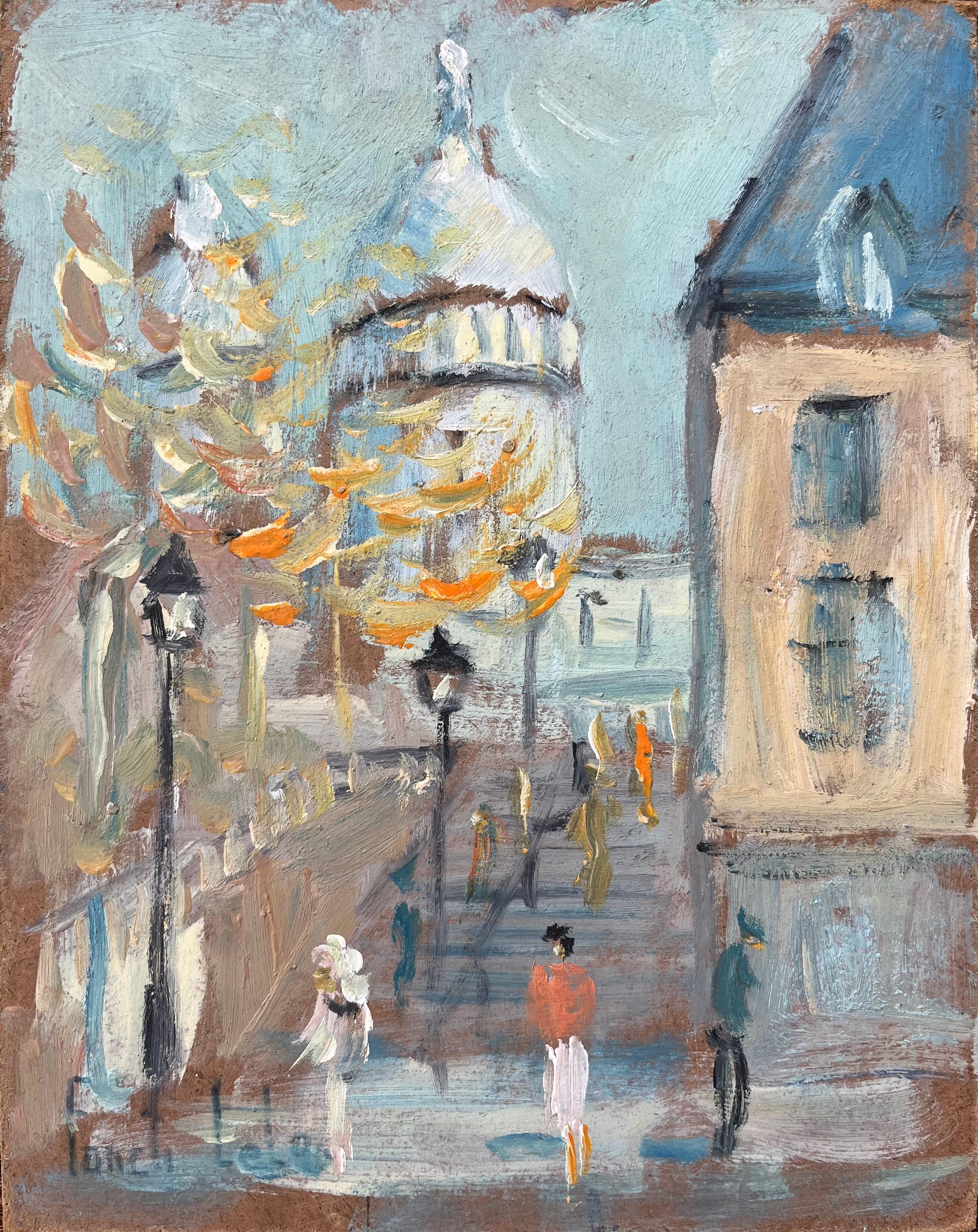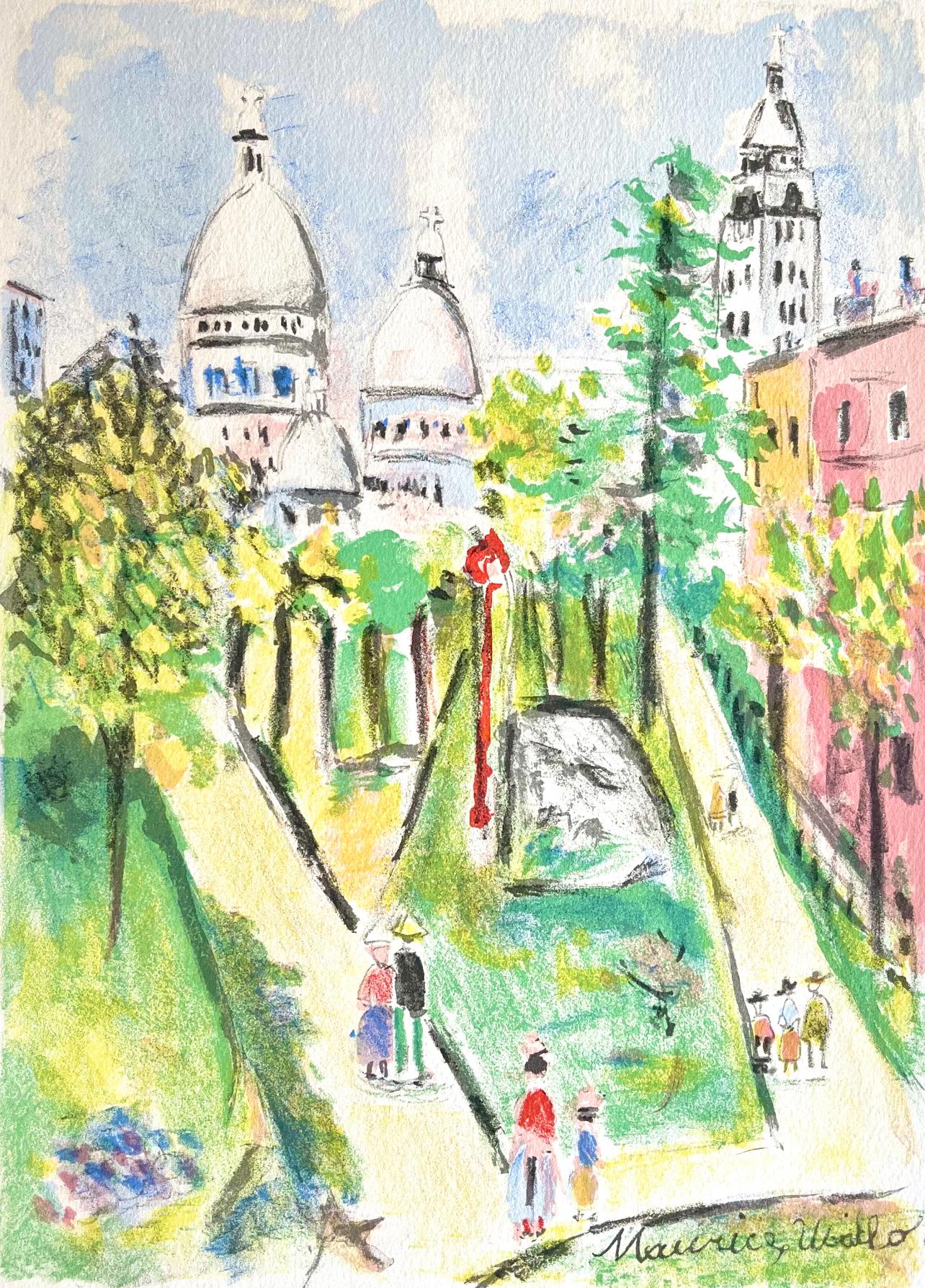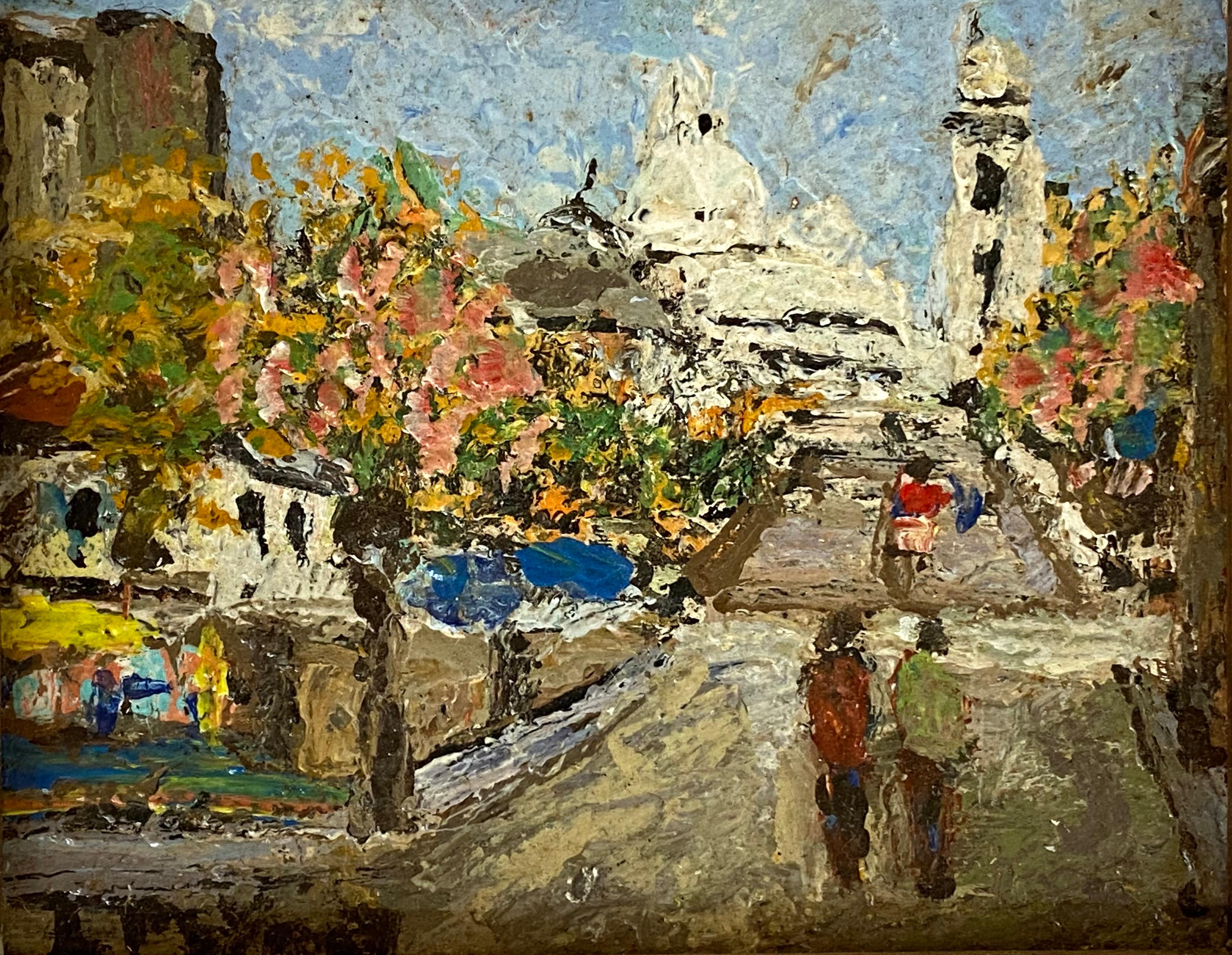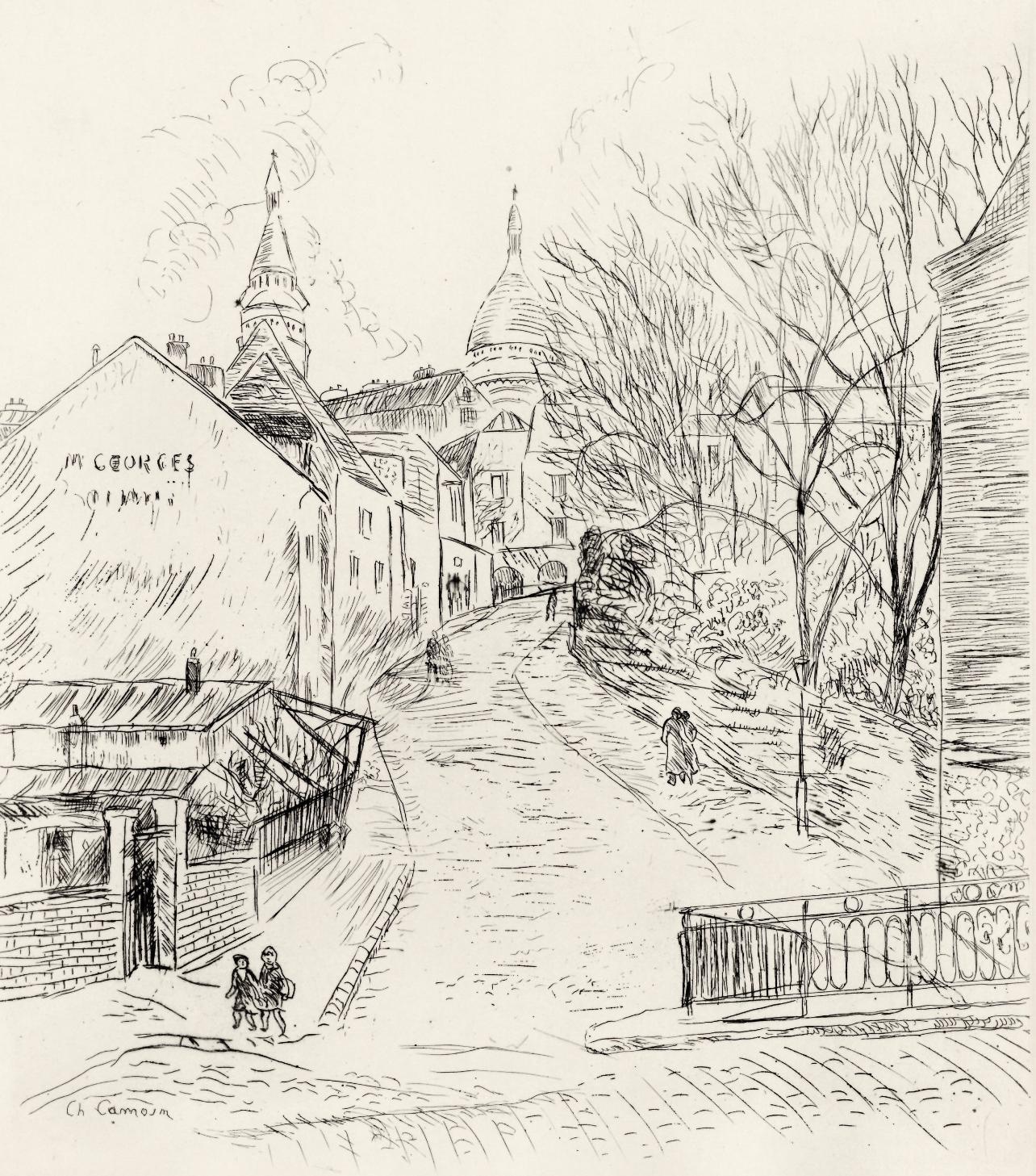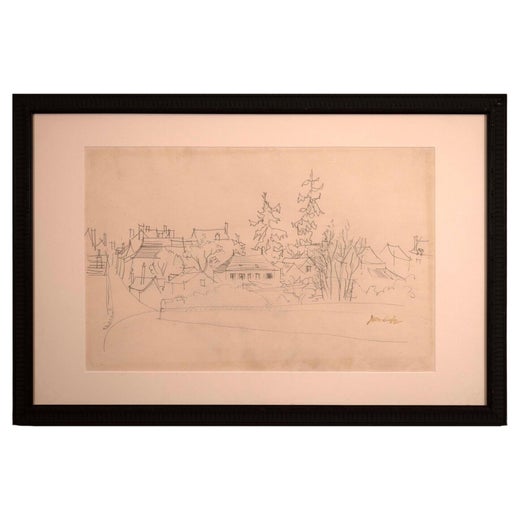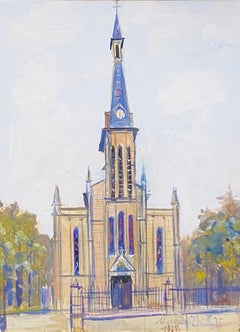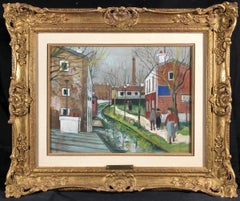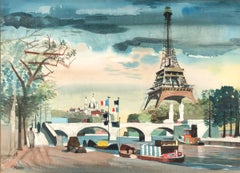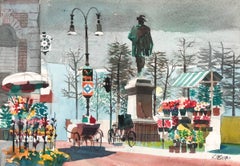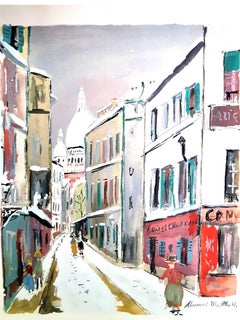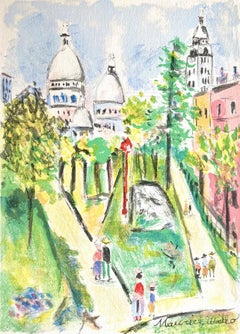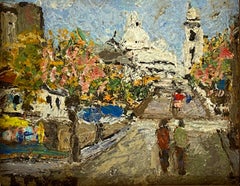Items Similar to Montmartre at Sacre Coeur
Want more images or videos?
Request additional images or videos from the seller
1 of 6
Jean DufyMontmartre at Sacre Coeurc. 1950
c. 1950
Price Upon Request
Price Upon Request
Price Upon Request
Price Upon Request
Price Upon Request
Price Upon Request
Price Upon Request
Price Upon Request
Price Upon Request
Price Upon Request
About the Item
Jean Dufy
"Montmartre et La Basilique du Sacre Coeur" c. 1950s
Color Lithograph
Signed in Pencil Lower Right
Numbered 78/250 Lower Left
Image Size: approx 18 3/4 x 24 3/4
Framed Size: approx. 30.25 x 35.25
From LeHavre and an arts-oriented family of eleven children including the famous Raoul Dufy (1877-1953), Jean Dufy showed artistic ability from childhood. Throughout his future career, his older brother, Raoul, encouraged him. Jean not only did fine-art painting but painted theatre sets. To earn money, he was a clerk for an overseas import business and even served as secretary on a transatlantic liner, La Savoie, which traveled between New York and Le Havre.
In these jobs, Dufy did much walking and observing around the port of Le Havre, and also became fascinated with modernist 'tradition breakers' such as Henri Matisse and Pablo Picasso.
He became a student in Le Havre at the l'Ecole des Beaux Arts, and his teachers included Raoul and A.E. Othon Friesz. When Raoul moved on to Paris, Jean Dufy dropped out of the Ecole in Le Havre to follow his brother "who remained his true master for the rest of his life." (Kodner) However, between these moves, he also served in the military from 1910 to 1912. For the next two years, living in Paris, he became associated with Cubist painters Picasso as well as Georges Braque and poet Guillame Apollinaire.
By 1914, he was exhibiting his early watercolors, "muted tones and somber browns, blues, and reds" mingling "with the hatching technique he inherited from Cézanne by way of his brother Raoul Dufy." The venue was the Berthe Weill Gallery. However, that same year, he was drafted for additional military service and was a soldier on horseback. Being stationed throughout France, he painted many landscape scenes including in the Vosges region where he was treated for war wounds.
Because of this close association, Jean Dufy's work, much of it in ink and watercolor, is often compared to that of his brother. Like Raoul, he chose Parisien subjects, "country scenes, circuses, horse races, stages and orchestras. . . . Raoul Dufy often dissected each of the elements that he used in his compositions, often with humor or tenderness, if not with acuteness. Jean, on the other hand, was more sensitive to the entire panorama of the scene represented, i.e. the particularity, the individuality, the 'hands on'. (Kodner)
Jean Dufy in 1916 worked briefly with his brother in a studio doing textile painting, and then began what became a major component of his career for the next 30 years---porcelain decoration for Haviland in Limoges, France. For skillful and creative execution of animal and floral designs, he received the International Exhibition of Decorative Arts gold medal in 1925 for a set he designed titled "Chateau de France".
By 1920, he was a member of the Salon d'Automne, where he exhibited in 1920, 1923, 1924, 1927 and 1932. Also bringing him increasing public attention was gallery representation in Paris at the Galerie Bing and in New York at Balzac and Peris Galleries. In 1937, he helped his brother, Raoul, with the completion of his assignment to oversee the decoration of the Electric Pavillion for the World's Fair. Together they did a mural, 600 meters in size, to celebrate electricity.
He established residency in Montmartre, living near the artist, Georges Braque. In addition to painting and decorative arts, Jean Dufy was a musician, playing the classical guitar, and was a jazz enthusiast, which some critics have linked to his rhythmic, fluid painting style. The interest in music likely is linked to his father, whose career was accounting for a metallurgy company and who was an amateur musician. The love of music of Dufy transferred to his artwork, and he did many brightly colored depictions of musicians in orchestra scenes and piano players. Among his associates were prominent avant-garde composers whose names remain famous such as Francis Poulenc, Arthur Honegger and Eric Satie.
Finding many painting subjects, Jean Dufy traveled extensively in the 1950s, the last decade of his life. He returned often to his hometown of Le Havre and to his mother's birthplace of Honfleur, as well as to many other locations in Europe and to North Africa. However, judging by his many scenes of Paris, it was the location that for him was most fascinating: "the streets, the horse-drawn carriages, the Eiffel Tower, the sky, and the Seine." (Bailly)
Jean Dufy died May 12, 1964 in the French village of Boussay. His wife, Ismérie, had died two months earlier.
- Creator:Jean Dufy (1888 - 1964, French)
- Creation Year:c. 1950
- Dimensions:Height: 30.25 in (76.84 cm)Width: 35.25 in (89.54 cm)
- Medium:
- Movement & Style:
- Period:
- Condition:
- Gallery Location:Missouri, MO
- Reference Number:1stDibs: LU74732601261
Jean Dufy
Jean Dufy was a French Art Deco artist, best known for his colourful, melodic depictions of post-war Parisian society. Working to capture everyday life, from concert halls and circuses to country landscapes and busy Parisian streets, Dufy focused on recreating the feeling and impression of a scene, rather than individual details. In 1906, Dufy visited the exhibition ‘Cercle de l’Art Moderne’ in La Havre, and it was this show that eventually inspired him to pursue an artistic career. The exhibit, one of Dufy’s first exposures to Modern Art, crucially shaped his approach to art and introduced him to artists such as Picasso and Matisse. While he had no formal training, his older brother was well-known French Fauvist Raoul Dufy, who served as his artistic mentor. In January 1914, Dufy launched his artistic career, holding his first show at Galerie Berthe Weil. He returned to Paris after the war and settled in the Montmartre district of Paris, moving next door to artist George Braque, who encouraged Dufy to experiment with Cubism. His personal painting style developed into a vibrant fusion of Post-Impressionism with a loose decorative approach to colour and line, which he achieved from his work in porcelain design. For almost 30 years, Dufy worked for Limoge porcelain manufacturer Theodore Haviland, hand-painting decorative designs of animals and flowers. At the 1925 L’exposition Internationale des Arts Décoratifs he was awarded a gold medal for designing the service ‘Châteaux de France’. Dufy participated in many exhibitions, including the Salon d’Automne, which reflected the popularity of jazz music and the art of Parisian culture after the war. Dufy would return to his native Normandy throughout his life and spent long stretches of time in the south of France. The dynamism of these landscapes and cityscapes - particularly noticeable in the street scene Route de Rives (Touraine)- are so cleverly captured due to Dufy’s uniquely musical and distinctive Post-Impressionistic style.
About the Seller
5.0
Vetted Professional Seller
Every seller passes strict standards for authenticity and reliability
Established in 1970
1stDibs seller since 2017
155 sales on 1stDibs
Typical response time: Several days
- ShippingRetrieving quote...Shipping from: Missouri, MO
- Return Policy
Authenticity Guarantee
In the unlikely event there’s an issue with an item’s authenticity, contact us within 1 year for a full refund. DetailsMoney-Back Guarantee
If your item is not as described, is damaged in transit, or does not arrive, contact us within 7 days for a full refund. Details24-Hour Cancellation
You have a 24-hour grace period in which to reconsider your purchase, with no questions asked.Vetted Professional Sellers
Our world-class sellers must adhere to strict standards for service and quality, maintaining the integrity of our listings.Price-Match Guarantee
If you find that a seller listed the same item for a lower price elsewhere, we’ll match it.Trusted Global Delivery
Our best-in-class carrier network provides specialized shipping options worldwide, including custom delivery.More From This Seller
View AllL'Eglise
By Maurice Utrillo
Located in Missouri, MO
Maurice Utrillo (1883-1955)
"L'Eglise" (Petrides No 25.562)
Created 1937
Signed and Dated Lower Right
Without Frame: 11" x 8.75"
With Frame: 21" x 17.5"
Provenance: Galerie Gilbert ...
Category
Late 19th Century French School Landscape Drawings and Watercolors
Materials
Paper, Watercolor, Gouache
Price Upon Request
Les Usines En Banlieue
By Maurice Utrillo
Located in Missouri, MO
"Les Usines En Banlieue" 1926
Gouache
31 x 40cm/approx. 12.5 x 16.75 inches
Signed and Dated Lower Right
Catalogue Raisonne: Petredies, Plate AG166, Page 190-191
Category
1920s Impressionist Landscape Drawings and Watercolors
Materials
Gouache
Price Upon Request
Paris and the Eiffel Tower (The City of Love)
By Dong Kingman
Located in Missouri, MO
This is by the great and legendary artist, Dong Kingman (1911-2000). See bio below.
Sheet Size: 22 x 30 inches
Signed
The following obituary is from Dong Kingman Jr., son of the artist:
DONG KINGMAN (1911-2000)
Dong Kingman, the world-renowned artist and teacher, died in his sleep on May 12, 2000 at age 89 in his home in Manhattan. The cause was pancreatic cancer.
Long acknowledged as an American watercolor master, he has received an extraordinary number of awards and honors throughout his 70-year career in the arts. Included are two Guggenheim fellowships in 1942 and 1943; the San Francisco Art Association First Purchase Prize, 1936; Audubon Artist Medal of Honor, 1946; Philadelphia Watercolor Club Joseph Pennel Memorial Medal, 1950; Metropolitan Museum of Art Award, and the National Academy Design 150th Anniversary Gold Medal Award, 1975.
In 1987, the American Watercolor Society awarded Dong Kingman its highest honor, the Dolphin Medal, "for having made outstanding contributions to art especially to that of watercolor."
His work is represented in the permanent collections of 50 museums and universities, including the Boston Museum of Fine Arts, M.H. deYoung Memorial Museum of Art, the Metropolitan Museum of Art, the Whitney Museum, Museum of Modern Art, Art Institute of Chicago, Pennsylvania Academy of Fine Arts, Sheldon Memorial Art Gallery and Sculpture Garden, Des Moines Art Center, Columbus Museum of Arts and Crafts, Brooklyn Museum and Hirshhorn Museum.
Born in Oakland, California in 1911 of Chinese descent, Kingman moved to Hong Kong at age five. He studied art and calligraphy in his formative years at the Lingnan School. The painting master Szeto Wai had recently studied art in Paris and took a keen interest in young Dongs precocious talents. He taught him both Chinese classical and French Impressionist styles of painting. Kingman returned home to Oakland when he was 18 at the height of the Depression. He worked as a newsboy and dishwasher to make ends meet.
When he was employed as a houseboy for the Drew family in San Francisco, he painted every spare moment. In a year, he created enough pictures to have a one-man show at the Art Center. It attracted the attention of San Francisco art critics who raved about Kingmans unique style. Wrote Junius Cravens of the San Francisco News: "That young Chinese artist is showing 20 of the freshest and most satisfying watercolors that have been seen hereabouts in many a day Kingman already has developed that universal quality which may place a sincere artist work above the limitations of either racial characteristics or schools. Kingmans art belongs to the world at large today." Dong Kingman became an overnight success.
From 1936 to 1941, he was a project artist for WPA and became a pioneer for a new school of painting, the "California Style." His two Guggenheim fellowships enabled him to travel the country painting American scenes. His first one-man show in New York at Midtown Galleries in 1942 was well received in the media, including Time, Newsweek, the New Yorker and American Artist. M.H. de Young Memorial Museum in San Francisco held a major exhibit of his watercolors in 1945.
In 1951, Midtown presented a 10-year retrospective of his work. Time Magazine wrote, "At age 40, Kingman is one of the worlds best watercolorists." Other retrospectives, including Corcoran in Washington,D.C. an d Witte Memorial Museum in San Antonio, were held for the artist. Kingman moved to Wildenstein (1958-1969) where he had successful exhibits in New York, London and Paris. Hammer Galleries exhibited his paintings in the 70s, and then the artist expanded his venues to the West Coast and Far East.
During World War II, he served with the OSS in Washington, D.C. where he was a cartographer. After his honorable discharge, Kingman moved to Brooklyn Heights from San Francisco when he became a guest lecturer and then art instructor at Columbia University (1946-1958). Hunter College also appointed him instructor in watercolors and Chinese Art (1948-1953). His teaching career continued with the Famous Artists School, Westport, CT in 1953, joining such distinguished artists on the faculty as Will Barnet, Stuart Davis, Norman Rockwell and Ben Shahn.
He also became a teaching member for 40 years for the Hewitt Painting Workshops, which conducts worldwide painting tours. He taught at the Academy of Art College in San Francisco, was a member of its board, and received an honorary doctorate from the Academy.
In 1954, the U.S. Department of State invited Kingman to go on a cultural exchange program tour around the world to give exhibitions and lectures and to meet local artists. When he came home, he presented the State Department with a 40-foot long report on a scroll, which later appeared in LIFE Magazine.
One of Kingman's most treasured experiences was his invitation by the Ministry of Culture of the Peoples Republic of China to exhibit in that country in 1981. He was the first American artist to be accorded a one-man show since diplomatic relations resumed. More than 100,000 visitors attended his exhibitions in Beijing, Hangzhou and Guangzhou and the retrospective received critical acclaim from the Chinese press. Noted the China Daily Mail, "Just as the master painters of the Song Dynasty roamed about mountain and stream to capture the rhythm of nature, Dong Kingman traveled the world capturing the dynamism of modern lifefamiliar scenes have been transformed into a vibrant new vision of life through color schemes with rhythms that play over the entire surface of the picture. The wind swept skies which enliven his watercolors remind us of the pleinairism of the French Impressionists."
Kingman, who has been fascinated with movies since seeing his first film "The Thief of Baghdad...
Category
1960s Modern Landscape Drawings and Watercolors
Materials
Watercolor
Price Upon Request
Flower Market, Oslo Norway
By Dong Kingman
Located in Missouri, MO
Dong Kingman
"Flower Market, Oslo Norway" c. 1950
watercolor on paper
signed
sheet size: 15 x 22 inches
framed size: approx 23.5 x 30.5 inches
DONG KINGMAN (1911-2000)
Dong Kingman, the world-renowned artist and teacher, died in his sleep on May 12, 2000 at age 89 in his home in Manhattan. The cause was pancreatic cancer.
Long acknowledged as an American watercolor master, he has received an extraordinary number of awards and honors throughout his 70-year career in the arts. Included are two Guggenheim fellowships in 1942 and 1943; the San Francisco Art Association First Purchase Prize, 1936; Audubon Artist Medal of Honor, 1946; Philadelphia Watercolor Club Joseph Pennel Memorial Medal, 1950; Metropolitan Museum of Art Award, and the National Academy Design 150th Anniversary Gold Medal Award, 1975.
In 1987, the American Watercolor Society awarded Dong Kingman its highest honor, the Dolphin Medal, "for having made outstanding contributions to art especially to that of watercolor."
His work is represented in the permanent collections of 50 museums and universities, including the Boston Museum of Fine Arts, M.H. deYoung Memorial Museum of Art, the Metropolitan Museum of Art, the Whitney Museum, Museum of Modern Art, Art Institute of Chicago, Pennsylvania Academy of Fine Arts, Sheldon Memorial Art Gallery and Sculpture Garden, Des Moines Art Center, Columbus Museum of Arts and Crafts, Brooklyn Museum and Hirshhorn Museum.
Born in Oakland, California in 1911 of Chinese descent, Kingman moved to Hong Kong at age five. He studied art and calligraphy in his formative years at the Lingnan School. The painting master Szeto Wai had recently studied art in Paris and took a keen interest in young Dongs precocious talents. He taught him both Chinese classical and French Impressionist styles of painting. Kingman returned home to Oakland when he was 18 at the height of the Depression. He worked as a newsboy and dishwasher to make ends meet.
When he was employed as a houseboy for the Drew family in San Francisco, he painted every spare moment. In a year, he created enough pictures to have a one-man show at the Art Center. It attracted the attention of San Francisco art critics who raved about Kingmans unique style. Wrote Junius Cravens of the San Francisco News: "That young Chinese artist is showing 20 of the freshest and most satisfying watercolors that have been seen hereabouts in many a day Kingman already has developed that universal quality which may place a sincere artist work above the limitations of either racial characteristics or schools. Kingmans art belongs to the world at large today." Dong Kingman became an overnight success.
From 1936 to 1941, he was a project artist for WPA and became a pioneer for a new school of painting, the "California Style." His two Guggenheim fellowships enabled him to travel the country painting American scenes. His first one-man show in New York at Midtown Galleries in 1942 was well received in the media, including Time, Newsweek, the New Yorker and American Artist. M.H. de Young Memorial Museum in San Francisco held a major exhibit of his watercolors in 1945.
In 1951, Midtown presented a 10-year retrospective of his work. Time Magazine wrote, "At age 40, Kingman is one of the worlds best watercolorists." Other retrospectives, including Corcoran in Washington,D.C. an d Witte Memorial Museum in San Antonio, were held for the artist. Kingman moved to Wildenstein (1958-1969) where he had successful exhibits in New York, London and Paris. Hammer Galleries exhibited his paintings in the 70s, and then the artist expanded his venues to the West Coast and Far East.
During World War II, he served with the OSS in Washington, D.C. where he was a cartographer. After his honorable discharge, Kingman moved to Brooklyn Heights from San Francisco when he became a guest lecturer and then art instructor at Columbia University (1946-1958). Hunter College also appointed him instructor in watercolors and Chinese Art (1948-1953). His teaching career continued with the Famous Artists School, Westport, CT in 1953, joining such distinguished artists on the faculty as Will Barnet, Stuart Davis, Norman Rockwell and Ben Shahn.
He also became a teaching member for 40 years for the Hewitt Painting Workshops, which conducts worldwide painting tours. He taught at the Academy of Art College in San Francisco, was a member of its board, and received an honorary doctorate from the Academy.
In 1954, the U.S. Department of State invited Kingman to go on a cultural exchange program tour around the world to give exhibitions and lectures and to meet local artists. When he came home, he presented the State Department with a 40-foot long report on a scroll, which later appeared in LIFE Magazine.
One of Kingman's most treasured experiences was his invitation by the Ministry of Culture of the Peoples Republic of China to exhibit in that country in 1981. He was the first American artist to be accorded a one-man show since diplomatic relations resumed. More than 100,000 visitors attended his exhibitions in Beijing, Hangzhou and Guangzhou and the retrospective received critical acclaim from the Chinese press. Noted the China Daily Mail, "Just as the master painters of the Song Dynasty roamed about mountain and stream to capture the rhythm of nature, Dong Kingman traveled the world capturing the dynamism of modern lifefamiliar scenes have been transformed into a vibrant new vision of life through color schemes with rhythms that play over the entire surface of the picture. The wind swept skies which enliven his watercolors remind us of the pleinairism of the French Impressionists."
Kingman, who has been fascinated with movies since seeing his first film "The Thief of Baghdad...
Category
1950s American Impressionist Landscape Drawings and Watercolors
Materials
Watercolor
Price Upon Request
Ponte di Donna Onesta, Venice
By John Marin
Located in Missouri, MO
Very rare etching by John Marin.
"Ponte di Donna Onesta, Venice" 1907
Original Etching
Hand Signed Lower Right
Titled Lower Left
Edition: c. 30
Cat. Rais: ...
Category
Early 1900s Abstract Landscape Prints
Materials
Etching
Price Upon Request
Buckingham Palace, London
By Dong Kingman
Located in Missouri, MO
Dong Kingman
"Buckingham Palace, London": c. 1950
watercolor on paper
signed
sheet size: 15 x 22 inches
framed size: approx 23.5 x 30.5 inches
DONG KINGMAN (1911-2000)
Dong Kingman, the world-renowned artist and teacher, died in his sleep on May 12, 2000 at age 89 in his home in Manhattan. The cause was pancreatic cancer.
Long acknowledged as an American watercolor master, he has received an extraordinary number of awards and honors throughout his 70-year career in the arts. Included are two Guggenheim fellowships in 1942 and 1943; the San Francisco Art Association First Purchase Prize, 1936; Audubon Artist Medal of Honor, 1946; Philadelphia Watercolor Club Joseph Pennel Memorial Medal, 1950; Metropolitan Museum of Art Award, and the National Academy Design 150th Anniversary Gold Medal Award, 1975.
In 1987, the American Watercolor Society awarded Dong Kingman its highest honor, the Dolphin Medal, "for having made outstanding contributions to art especially to that of watercolor."
His work is represented in the permanent collections of 50 museums and universities, including the Boston Museum of Fine Arts, M.H. deYoung Memorial Museum of Art, the Metropolitan Museum of Art, the Whitney Museum, Museum of Modern Art, Art Institute of Chicago, Pennsylvania Academy of Fine Arts, Sheldon Memorial Art Gallery and Sculpture Garden, Des Moines Art Center, Columbus Museum of Arts and Crafts, Brooklyn Museum and Hirshhorn Museum.
Born in Oakland, California in 1911 of Chinese descent, Kingman moved to Hong Kong at age five. He studied art and calligraphy in his formative years at the Lingnan School. The painting master Szeto Wai had recently studied art in Paris and took a keen interest in young Dongs precocious talents. He taught him both Chinese classical and French Impressionist styles of painting. Kingman returned home to Oakland when he was 18 at the height of the Depression. He worked as a newsboy and dishwasher to make ends meet.
When he was employed as a houseboy for the Drew family in San Francisco, he painted every spare moment. In a year, he created enough pictures to have a one-man show at the Art Center. It attracted the attention of San Francisco art critics who raved about Kingmans unique style. Wrote Junius Cravens of the San Francisco News: "That young Chinese artist is showing 20 of the freshest and most satisfying watercolors that have been seen hereabouts in many a day Kingman already has developed that universal quality which may place a sincere artist work above the limitations of either racial characteristics or schools. Kingmans art belongs to the world at large today." Dong Kingman became an overnight success.
From 1936 to 1941, he was a project artist for WPA and became a pioneer for a new school of painting, the "California Style." His two Guggenheim fellowships enabled him to travel the country painting American scenes. His first one-man show in New York at Midtown Galleries in 1942 was well received in the media, including Time, Newsweek, the New Yorker and American Artist. M.H. de Young Memorial Museum in San Francisco held a major exhibit of his watercolors in 1945.
In 1951, Midtown presented a 10-year retrospective of his work. Time Magazine wrote, "At age 40, Kingman is one of the worlds best watercolorists." Other retrospectives, including Corcoran in Washington,D.C. an d Witte Memorial Museum in San Antonio, were held for the artist. Kingman moved to Wildenstein (1958-1969) where he had successful exhibits in New York, London and Paris. Hammer Galleries exhibited his paintings in the 70s, and then the artist expanded his venues to the West Coast and Far East.
During World War II, he served with the OSS in Washington, D.C. where he was a cartographer. After his honorable discharge, Kingman moved to Brooklyn Heights from San Francisco when he became a guest lecturer and then art instructor at Columbia University (1946-1958). Hunter College also appointed him instructor in watercolors and Chinese Art (1948-1953). His teaching career continued with the Famous Artists School, Westport, CT in 1953, joining such distinguished artists on the faculty as Will Barnet, Stuart Davis, Norman Rockwell and Ben Shahn.
He also became a teaching member for 40 years for the Hewitt Painting Workshops, which conducts worldwide painting tours. He taught at the Academy of Art College in San Francisco, was a member of its board, and received an honorary doctorate from the Academy.
In 1954, the U.S. Department of State invited Kingman to go on a cultural exchange program tour around the world to give exhibitions and lectures and to meet local artists. When he came home, he presented the State Department with a 40-foot long report on a scroll, which later appeared in LIFE Magazine.
One of Kingman's most treasured experiences was his invitation by the Ministry of Culture of the Peoples Republic of China to exhibit in that country in 1981. He was the first American artist to be accorded a one-man show since diplomatic relations resumed. More than 100,000 visitors attended his exhibitions in Beijing, Hangzhou and Guangzhou and the retrospective received critical acclaim from the Chinese press. Noted the China Daily Mail, "Just as the master painters of the Song Dynasty roamed about mountain and stream to capture the rhythm of nature, Dong Kingman traveled the world capturing the dynamism of modern lifefamiliar scenes have been transformed into a vibrant new vision of life through color schemes with rhythms that play over the entire surface of the picture. The wind swept skies which enliven his watercolors remind us of the pleinairism of the French Impressionists."
Kingman, who has been fascinated with movies since seeing his first film "The Thief of Baghdad...
Category
1950s American Modern Landscape Drawings and Watercolors
Materials
Watercolor
Price Upon Request
You May Also Like
Sacré Coeur - Village of Montmartre - Pochoir
By (after) Maurice Utrillo
Located in Collonge Bellerive, Geneve, CH
(after) Maurice Utrillo
Inspired Village of Montmartre
Pochoir with printed signature
Edition of 490
Dimensions: 39 x 30 cm
Information : This print was created for the portfolio "Le Village inspiré, Chronique de la bohème de Montmartre (1920-1950) " published by Vertex in 1950
Condition : Excellent
Maurice Utrillo (1883 - 1955)
The French painter Maurice Utrillo was born as the illegitimate son of the painter Suzanne Valladon in Paris on December 26, 1883. He was adopted by the Catalan art critic Miguel Utrillo...
Category
1950s Modern Landscape Prints
Materials
Stencil
French Impressionist Oil Painting of Montmartre with a View of Sacré-Cœur
By Fanch Lel
Located in Cirencester, Gloucestershire
Title: French Impressionist Oil Painting of Montmartre with a View of Sacré-Cœur
By Fanch Lel (French b. 1930)
Size: 9.5 x 7.5 inches (height x width)
Signed: Yes
Oil painting on boa...
Category
20th Century Impressionist Landscape Paintings
Materials
Oil
Montmartre (Place Saint-Pierre), Paris Capitale, Maurice Utrillo
By Maurice Utrillo
Located in Southampton, NY
Lithograph on vélin Johannot paper. Inscription: Unsigned and unnumbered. Good condition. Notes: From the folio, Paris Capitale, 1955; published by Joseph Foret, Editeur d'Art, Paris...
Category
1950s Modern Landscape Prints
Materials
Lithograph, Stencil
$1,436 Sale Price
20% Off
Free Shipping
”View of Sacre Coeur, Montmartre”
Located in Southampton, NY
Miniature oil on board original painting of a view of Sacre Coeur from the street in Montmartre, Paris. France. Circa 1975. Signed illegibly lower left. Condition is excellent. O...
Category
1970s Post-Impressionist Landscape Paintings
Materials
Board, Oil
$260 Sale Price
20% Off
Montmartre, A La gloire à Paris, Charles Camoin
By Charles Camoin
Located in Southampton, NY
Etching on vélin Canson et Montgolfier paper. Unsigned and unnumbered, as issued. Good condition. Published by L'Imprimerie Daragnès, Paris; printed by Jean Gabriel Daragnès, Paris, ...
Category
1930s Modern Landscape Prints
Materials
Etching
$716 Sale Price
20% Off
Free Shipping
Le Vin Contre la Depression Nerveuse et l'Anemie
By Raoul Dufy
Located in Laguna Beach, CA
“My eyes were made to erase all that is ugly”. -Raoul Dufy
Raoul Dufy’s depictions for an instant charmer of a "medical book" illustrates the myriad benefits of wine, while being sp...
Category
1930s Post-Impressionist Landscape Prints
Materials
Lithograph
More Ways To Browse
Porcelain D Art Limoges France
Raoul Dufy Orchestra
W Rochelle
Welliver Screen Print
Wilbur Streech
William Irvine
William Simpson On Sale
Wysocki Charles Signed
Karapet Balakeseryan
Kuno Vollet Orbit
Lanvin Arpege Perfume
Lner Poster
Lone Ranger
Marina City
Mr Brainwash Life Is Beautiful
Painting Of Duck
Rachel Green
Red Pill Art
